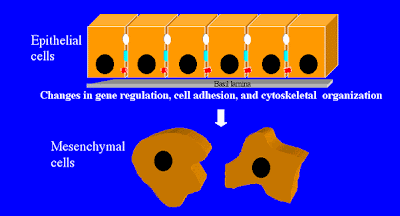
The three letter acronym EMT: what should it mean to nephrologists? Not just "emergency medical technician"...but also "epithelial-to-mesenchymal transition."
As we all know the nephron is comprised of a long tube of highly-differentiated epithelial cells. These cells have clearly defined apical and basolateral membranes, tight junctions, and cilia. Under normal conditions, these cells should remain epithelial cells for the duration of their lifespan. However, under various pathologic conditions they may become mesenchymal cells, which are less differentiated, lack such an obvious apical-basolateral polarity, and have an absence of tight junctions. One current hypothesis is that the renal parenchymal fibrosis that characterizes CKD is due to a TGF-beta-mediated epithelial-to-mesenchymal transition of tubular cells, turning them into more of a fibroblast-like cell type which secretes extracellular matrix.
The same type of cellular re-programming is seen in cancers which derive from well-differentiated epithelium (e.g., colon cancer, breast cancer) but develop into metastatic, poorly-differentiated cells.
During development, the EMT process essentially works in reverse: you start with mesenchymal cells, and via cross-talk between the metanephric mesenchyme and the ureteric bud there is a gradual commitment of cells to an epithelial morphology.















No comments:
Post a Comment